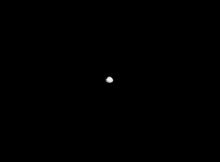逼近飛行


逼近飛行(英語:flyby),或稱飛掠[1],是一種航天器的外空飛行動作,描述航天器抵近並掠過另一空間物體而不進入其環繞軌道。[2]該物體一般是太空探索的目標或引力助推的引力源。有的航天器專為逼近飛行設計(如旅行者1號和2號)。逼近飛行有時還用於描述小行星從地球附近掠過。[2][3]恰當的時間和距離是逼近飛行成功的關鍵。[4]
航天器的逼近飛行
[編輯]對於航天器來說,逼近飛行的對象可以是行星、衛星、太陽系小天體等各種天體。[5][6]
在人類航天史上,常有航天器對行星做逼近飛行:
同樣也有航天器對彗星做過逼近飛行。1985年9月,國際彗星探測器(ISEE-3)飛掠賈可比尼-秦諾彗星的彗核,探測器與彗核的距離最近僅有約4,800英里(7,700公里)。[5]
月球曾同樣成為逼近飛行的對象。[7]阿波羅13號執行登月任務時,服務艙的氧氣瓶損壞,其不得不在對月球做逼近飛行後放棄任務,脫離混合軌道,進入返回軌道返回地球。[8]阿爾忒彌斯2號[9]和親愛的月球計畫中同樣包含飛掠月球任務。
火星
[編輯]
對火星做逼近飛行的成功產生出一個設想——飛掠火星交會對接,即在火星登陸計劃中,返回飛行器不再進入火星軌道,而是在對火星做逼近飛行動作之前或之後與從火星上發射的着陸飛行器對接。[10]20世紀60年代,美國國家航空航天局(NASA)下屬的林登·約翰遜太空中心曾對該方案進行了評估[10]。當時,NASA設計了一種航天器——火星漫遊艙,組件包括火星登陸艙,短期表面居留艙和爬升艙。從火星返回時,爬升艙將在另一飛行器飛掠火星時與其對接,而該飛行器無需進入火星軌道。[10]與火星軌道交會對接相比,飛掠火星交會對接方案無需航天器繞火飛行。因此,航天器在離開火星時無需脫離火星軌道,大大節省了燃料。[10]
探測器水手4號於1965年7月飛掠火星,傳回了當時最精確的火星大氣數據和拍攝位置距離火星地表最近的照片。[11]
1969年,水手6號和水手7號飛掠火星,傳回的數據革新了當時人們對火星的認識。[12][13]兩顆探測器上搭載的紅外輻射計傳回的結果顯示火星大氣層的成分主要是二氧化碳,它們還檢測到了在火星大氣中的微量水蒸氣。[12]
2018年,一對MarCO立方體中繼衛星隨洞察號着陸器一併發射,任務是在着陸器進入火星大氣(EDL)時提供通信中繼服務。[14]11月26日,所有MarCO衛星抵達火星,並成功為洞察號的進入、下降和着陸[註 1]階段提供信號中繼。[15]後其進入深空,並分別於2018年12月和2019年1月失去聯繫。[16]
柯伊伯帶
[編輯]
2015年7月,新視野號探測器成功飛掠冥王星,其當時距離太陽32.9個天文單位。2019年元旦,其到達距離2014 MU69最近位置,並完成對該小行星的飛掠探測,此時其距離太陽43.6個天文單位。[17][18]
卡西尼號探測器
[編輯]
卡西尼號探測器 · 土星 · 土衛二 · 土衛六 · 土衛八
於1997年發射往土星的卡西尼-惠更斯號探測器在2004至2007年間完成了一系列對土星衛星的逼近飛行,包括土星的最大衛星土衛六。[4] 其於2004年10月首次飛掠土衛六。[4]此後又完成了大量對土星衛星的飛掠探測。[19]2017年4月22日,其第126次也是最後一次飛掠土衛六。9月15日,該探測器飛入土星大氣焚毀,結束了其近20年的土星旅途。[20]
彗星
[編輯]
1985年月11日,國際彗星探測器(ISEE-3)飛越了賈可比尼-秦諾彗星的離子尾,對其進行飛掠探測,最近僅距離彗核7,800 km(4,800 mi) 。[21]
2010年,EPOXI任務的深度撞擊號在撞擊坦普爾1號彗星的彗核之後,執行了對哈特雷二號彗星逼近飛行並探測的任務。[22]
自然天體的逼近飛行
[編輯]
逼近飛行有時也用於描述天體的飛行軌跡,如小行星接近並掠過地球。但這種用法並不嚴謹。[23][24]
2014年,一顆彗星飛掠火星。[25]
2016年,小行星P/2016 BA14飛掠地球時,最近距離地球3,500,000 km(2,200,000 mi)。通過觀測得到的數據,人們得以算出其直徑約為3,300英尺(1.0 km)。[26] [26]
2018年12月16日,短周期彗星46P/Wirtanen飛掠地球,最近距離地球7,100,000 mi(11,400,000 km)。[27]
注釋
[編輯]- ^ 飛行器進入行星大氣並着陸分為3個階段,分別是進入(entry)、下降(descent)和着陸(landing),縮寫為EDL。
參見
[編輯]參考資料
[編輯]- ^ flyby - 飛掠. 國家教育研究院. [2021-09-10]. (原始內容存檔於2021-09-10).
- ^ 2.0 2.1 Basics of Space Flight - Solar System Exploration: NASA Science. Solar System Exploration: NASA Science. [2018-11-04]. (原始內容存檔於2019-06-02).
- ^ 'Tunguska'-Size Asteroid Makes Surprise Flyby of Earth. Space.com. [2018-11-04]. (原始內容存檔於2021-12-18).
- ^ 4.0 4.1 4.2 Titan A Flyby Closest Approach. sci.esa.int. [2018-11-04]. (原始內容存檔於2019-03-28) (英國英語).
- ^ 5.0 5.1 Our SpaceFlight Heritage: ICE—The first comet flyby. SpaceFlight Insider. 2018-09-12 [2018-11-04]. (原始內容存檔於2021-12-18) (美國英語).
- ^ First mission to Mars: Mariner 4's special place in history | Cosmos. cosmosmagazine.com. 2017-07-13 [2018-11-04]. (原始內容存檔於2018-11-04) (英語).
- ^ SpaceX says its BFR will fly someone around the Moon; we have questions. Ars Technica. [2018-11-04]. (原始內容存檔於2022-06-03) (美國英語).
- ^ Woods, W. David; Kemppanen, Johannes; Turhanov, Alexander; Waugh, Lennox J. Day 3: 'Houston, we've had a problem'. Apollo Lunar Flight Journal. 2017-05-30 [2019-08-18]. (原始內容存檔於2020-12-12).
- ^ esa. Exploration Mission 2. European Space Agency. [2019-01-02]. (原始內容存檔於2019-01-07) (英國英語).
- ^ 10.0 10.1 10.2 10.3 Portree, David S. F. Chapter 3: EMPIRE and After (PDF). Humans to Mars: Fifty Years of Mission Planning, 1950 - 2000. NASA Monographs in Aerospace History Series. National Aeronautics and Space Administration. February 2001: 15–16 [2014-07-18]. (原始內容 (PDF)存檔於2021-10-16).
|number=被忽略 (幫助) - ^ Origin of the Apollo-shaped Manned Mars Lander (1966). WIRED. 2012-10-25 [2018-03-04]. (原始內容存檔於2018-07-18).
- ^ 12.0 12.1 Infrared Spectrometer and the Exploration of Mars. American Chemical Society. [2018-12-26]. (原始內容存檔於2018-12-09) (英語).
- ^ Chdse, S. C. Infrared radiometer for the 1969 mariner mission to Mars. Applied Optics. 1969-03-01, 8 (3): 639. Bibcode:1969ApOpt...8..639C. ISSN 1559-128X. PMID 20072273. doi:10.1364/AO.8.000639.
- ^ MarCO: CubeSats to Mars!. www.planetary.org. [2018-11-26]. (原始內容存檔於2019-08-29) (英語).
- ^ Touchdown on Mars! NASA's InSight Lands to Peer Inside the Red Planet. Space.com. [2018-11-26]. (原始內容存檔於2022-05-19).
- ^ Good, Andrew; Wendel, JoAnna. Beyond Mars, the Mini MarCO Spacecraft Fall Silent. Jet Propulsion Laboratory (NASA). 2019-02-04 [2019-02-05]. (原始內容存檔於2020-01-08).
- ^ Bagenal, F.; Delamere, P. A.; Elliott, H. A.; Hill, M. E.; Lisse, C. M.; McComas, D. J.; McNutt Jr, R. L.; Richardson, J. D.; Smith, C. W.; Strobel, D. F. Solar wind at 33 AU: Setting bounds on the Pluto interaction for New Horizons. Journal of Geophysical Research: Planets. 2015, 120 (9): 1497–1511. Bibcode:2015JGRE..120.1497B. S2CID 118518239. arXiv:1509.04660
 . doi:10.1002/2015JE004880.
. doi:10.1002/2015JE004880.
- ^ New Horizons. pluto.jhuapl.edu. [2018-10-26]. (原始內容存檔於2015-05-09) (英語).
- ^ Titan Flyby T-126: Final Close Encounter, Gateway to the Grand Finale. [2021-09-08]. (原始內容存檔於2022-05-11).
- ^ Titan Flyby T-126: Final Close Encounter, Gateway to the Grand Finale. Solar System Exploration: NASA Science. [2019-01-03]. (原始內容存檔於2022-05-11).
- ^ Stelzried, C.; Efron, L.; Ellis, J. Halley Comet Missions (PDF) (報告). NASA: 241–242. July–September 1986 [2021-09-08]. TDA Progress Report 42-87. (原始內容 (PDF)存檔於2014-08-21).
- ^ Grossman, Lisa. New Super Close-Up Images From Comet Flyby. Wired. 2010-11-04 [2019-01-01]. ISSN 1059-1028. (原始內容存檔於2010-11-07).
- ^ Two Small Asteroids Are Buzzing Earth This Weekend. See One Live Tonight!. Space.com. [2018-11-04]. (原始內容存檔於2021-12-18).
- ^ Asteroid seen after it makes the closest flyby of the year. CNET. 2018-08-13 [2018-11-04]. (原始內容存檔於2021-12-18) (英語).
- ^ Comet's 2014 Mars Flyby Caused Most Intense Meteor Shower Ever Recorded. Space.com. [2018-11-04]. (原始內容存檔於2021-12-18).
- ^ 26.0 26.1 Flyby Comet Was WAY Bigger Than Thought. Space.com. [2018-11-07]. (原始內容存檔於2022-04-06).
- ^ Brightest comet of the year will zoom near Earth this week. [2021-09-08]. (原始內容存檔於2021-12-18).
